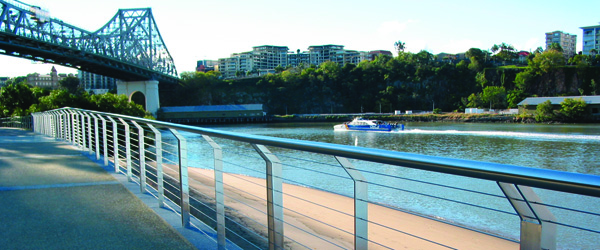Posted 1 July 2003

Architect Jan Jensen was a consultant to Brisbane City Council on the design of the Brisbane Riverwalk, currently under construction. The walk will take pedestrians from the CBD to the inner suburb of New Farm along the river.
At this proximity to Moreton Bay, the water is brackish and the air salt-laden - it is destructive to most construction materials. Corrosion-resistant stainless steel was chosen for this landmark project to deliver the 100 year service life required by the asset owner.
The structure consists of floating pontoons, reinforced with 316 stainless steel deformed bar. There are stainless steel balustrades and light poles and a suite of stainless street furniture.
Jensen describes the process of specifying the correct finish, including gaining a theoretical understanding and producing prototypes:
The Starting Point
As a key parameter of design responsibility 'value for money' the decision to use stainless steel was an easy one. Our rationale was: "It doesn't corrode and our work is in salt-affected air; it lasts forever; it is low maintenance; it will save us money and keep on looking good."
We needed a specification to let contracts for the manufacture of street and riverscape elements. Writing a specification required describing and reproducing the manufacturing process exactly to get reliable, predictable, consistent and economic results.
Our research took us to ASSDA's timely seminar on the fifty most frequently asked questions about stainless steel, where we were able to ask about tea-staining and how to avoid it.
Then we talked to manufacturers. The answers to our questions about surface roughness and the finishes available made us realise there were variations within the industry and we needed to define our requirements with scientific precision. Specifically, we needed to know the surface roughness (Ra) in microns (µm), as the labels 2B, No. 4 and so on refer to the method used to achieve the finish and comprise an Ra range.
Building Prototypes
We concluded that to write our specification we needed to build the product first to set it within the theory and the 'standard range of common industry manufacturing practice'. We commissioned prototypes of a balustrade and a light pole then the furniture suite for the Riverwalk: seats, bollards, bins, lights, sign posts and drinking fountain.
Forge Brothers Engineering produced the prototypes. It drew on the expertise of ASSDA and its members University of Queensland Materials Performance, 3M Australia, Heat & Control, Condamine Wellscreens, Ronstan International as well as AbrasiveFlex and Dana Ridge.
We soon realised that:
> The common system of finish grades is not a measure of surface roughness, eg the Ra of No. 4 finish products measures anywhere from 0.45 to 0.8µm depending on product form and supplier. Typical Ra for sheet is 0.3 to 0.4µm while it is not unusual for other products such as flat bar to be rougher. Thick plate, thin plate (sheet), tube, flat bar and hollow bar are manufactured by different processes which produce different finishes. The surface finish changes in hot rolled plate and gets smoother as the plate reduces in thickness.
> Ra meters were not commonly used in the industry although their use is growing.
> All abrasives aren't the same. Wear and tear and pressure make a difference. We tested non-woven abrasive belts, Trizact belts, air wheels and silicon carbide.
> The electro-polishing industry uses a variety of chemical baths and voltages.
Towards a Specification
In arriving at our specification we learned:
> Best practice calls for a finish below 0.5µm combined with electro-polishing to eliminate sulphides and increase the chromium content of the exposed surface.
> Wet blasting at low air pressure levels with a water and abrasive bead mix provides a consistent surface finish and economically removes surface variations ready for electro-polishing. This avoids the unexpected rise in roughness which can occur when electro-polishing removes microscopic peaks, previously flattened by mechanical polishing, to uncover underlying pits.
The proof that our specification works can be seen on the Brisbane River. After twelve months in a salt air environment our prototypes are still looking clean and new.
Words by Jan Jensen.
This article featured in Australian Stainless magazine - Issue 25, July 2003.